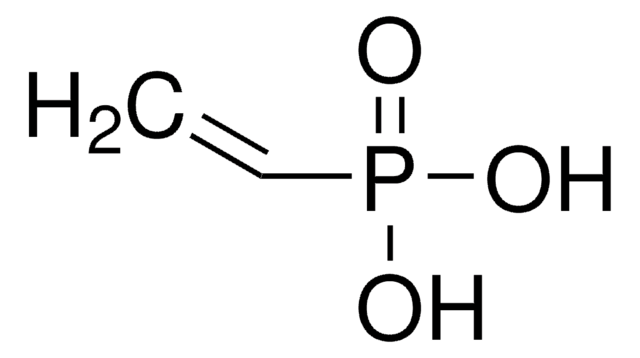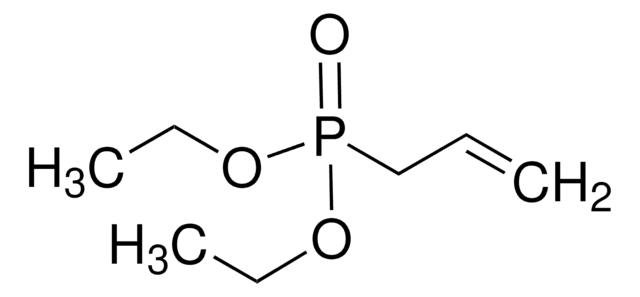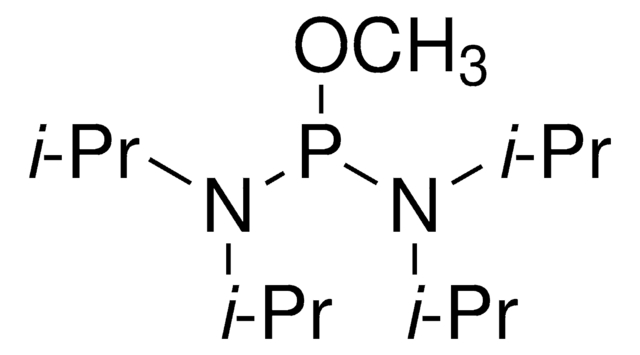496758
Bis[2-(methacryloyloxy)ethyl] phosphate
Sinonimo/i:
2-Hydroxyethyl methacrylate phosphate, Bis(2-methacryloyloxyethyl) acid phosphate, Bis(2-methacryloyloxyethyl) hydrogen phosphate, Bis(methacryloyloxyethyl) hydrogen phosphate, Bis(methacryloyloxyethyl) phosphate, Bis[2-(methacryloyloxy)ethyl] phosphate, Di(2-methacryloyloxyethyl) phosphate, Di-2-methacryloyloxyethyl acid phosphate
About This Item
Prodotti consigliati
Indice di rifrazione
n20/D 1.47 (lit.)
P. eboll.
221 °C (lit.)
Densità
1.28 g/mL at 25 °C (lit.)
Temperatura di conservazione
2-8°C
Stringa SMILE
CC(=C)C(=O)OCCOP(O)(=O)OCCOC(=O)C(C)=C
InChI
1S/C12H19O8P/c1-9(2)11(13)17-5-7-19-21(15,16)20-8-6-18-12(14)10(3)4/h1,3,5-8H2,2,4H3,(H,15,16)
NXBXJOWBDCQIHF-UHFFFAOYSA-N
Categorie correlate
Descrizione generale
Applicazioni
- As a bifunctional crosslinker to synthesize superabsorbent polymers (SAPs) via free radical polymerization. These SAPs can be used for agricultural applications.
- To prepare self-etching primer formulations for enamel and dentine. Primers with BMEP exhibit good wetting, etching, and penetration in both dentine and enamel.
- As a precursor to synthesize fire retardant nanocomposites via suspension polymerization.
Caratteristiche e vantaggi
- Presence of dimethacrylate groups enables cross-linking and improves copolymerization.
- Hydrophilicity and short carbon chains can enhance wetting.
Avvertenze
Warning
Indicazioni di pericolo
Consigli di prudenza
Classi di pericolo
Eye Irrit. 2 - Skin Irrit. 2 - STOT SE 3
Organi bersaglio
Respiratory system
Codice della classe di stoccaggio
10 - Combustible liquids
Classe di pericolosità dell'acqua (WGK)
WGK 3
Punto d’infiammabilità (°F)
Not applicable
Punto d’infiammabilità (°C)
Not applicable
Dispositivi di protezione individuale
Eyeshields, Gloves, type ABEK (EN14387) respirator filter
Certificati d'analisi (COA)
Cerca il Certificati d'analisi (COA) digitando il numero di lotto/batch corrispondente. I numeri di lotto o di batch sono stampati sull'etichetta dei prodotti dopo la parola ‘Lotto’ o ‘Batch’.
Possiedi già questo prodotto?
I documenti relativi ai prodotti acquistati recentemente sono disponibili nell’Archivio dei documenti.
I clienti hanno visto anche
Il team dei nostri ricercatori vanta grande esperienza in tutte le aree della ricerca quali Life Science, scienza dei materiali, sintesi chimica, cromatografia, discipline analitiche, ecc..
Contatta l'Assistenza Tecnica.

![[2-(Methacryloyloxy)ethyl]dimethyl-(3-sulfopropyl)ammonium hydroxide 95%](/deepweb/assets/sigmaaldrich/product/structures/217/219/73c91e1c-0ee4-4b3d-bead-a6dc3d09d1da/640/73c91e1c-0ee4-4b3d-bead-a6dc3d09d1da.png)











